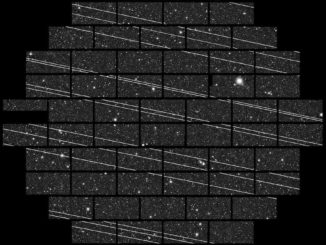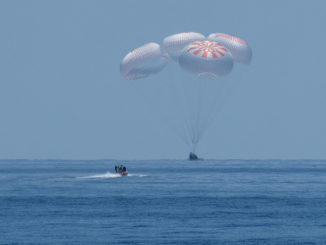
A day after bad weather in the booster recovery zone forced a mission scrub, SpaceX launched its latest batch of 21 Starlink satellites. Liftoff from Cape Canaveral Space Force Station in Florida happened Saturday morning at 8:50 a.m. EDT (1250 UTC).
The booster flying this mission, tail number B1067 in the SpaceX fleet, made its 21st flight, successfully landing on the droneship, ‘Just Read the Instructions,’ a little more than eight minutes after liftoff.
The remnants of Tropical Storm Debby moved far enough up the East Coast, to allow the launch to proceed on Saturday.
Prior this its latest Starlink mission, Falcon 9 booster, B1067, flew a fifth of its previous missions in support of NASA. It launched the Crew-3 and Crew-4 astronaut missions to the International Space Station as well as two cargo missions as part of its Commercial Resupply Services 2 contract. B1067 also launched 11 previous batches of Starlink satellites.
The successful booster landing on JRTI marked the 88 touchdown for that droneship and the 336th booster landing to date.
Among the 21 Starlink satellites flying are 13 that support SpaceX’s Direct to Cell capabilities. The Starlink 8-3 mission was the 55th dedicated Starlink launch in 2024 and the 118th launch of the V2 Mini variety of the satellites.
Following payload deployment, there will be a total of 142 DTC Starlink satellites on orbit.

Musical chairs launch schedule
The mission comes near the tail end of a week that has included the announcement of big changes to SpaceX’s launch manifest. On Tuesday, NASA announced that the upcoming Crew-9 mission would push from no earlier than August 18 to no earlier than September 24.
The move allows more time for the agency to reach a conclusion regarding how to end the Boeing Crew Flight Test. Part of those deliberations includes choosing on which vehicle to bring Butch Wilmore and Sunita Williams back to Earth.
If NASA ultimately decides to use the SpaceX Crew Dragon, that will mean the Crew-9 mission will launch with only two people on board. NASA officials declined to name which two would be flying.
We are targeting no earlier than August 26 for the launch of Polaris Dawn pic.twitter.com/tkkiRke64a
— Polaris (@PolarisProgram) August 7, 2024
The shuffle also means that the commercial astronaut mission, Polaris Dawn, will now target the launch of its four-person crew on a five-day mission no earlier than Aug. 26. The CRS-31 Cargo Dragon flight will also move to a launch in mid-October.
Meanwhile, on Thursday, SpaceX announced on social media that the hardware supporting Flight 5 of its Starship program is ready for launch, pending regulatory approval. The ambitious mission seeks to use the launch tower, nicknamed ‘Mechazilla,’ to catch the Super Heavy booster after stage separation.
Flight 5 Starship and Super Heavy are ready to fly, pending regulatory approval. Additional booster catch testing and Flight 6 vehicle testing is planned while waiting for clearance to fly pic.twitter.com/FFoGPEtztI
— SpaceX (@SpaceX) August 8, 2024



